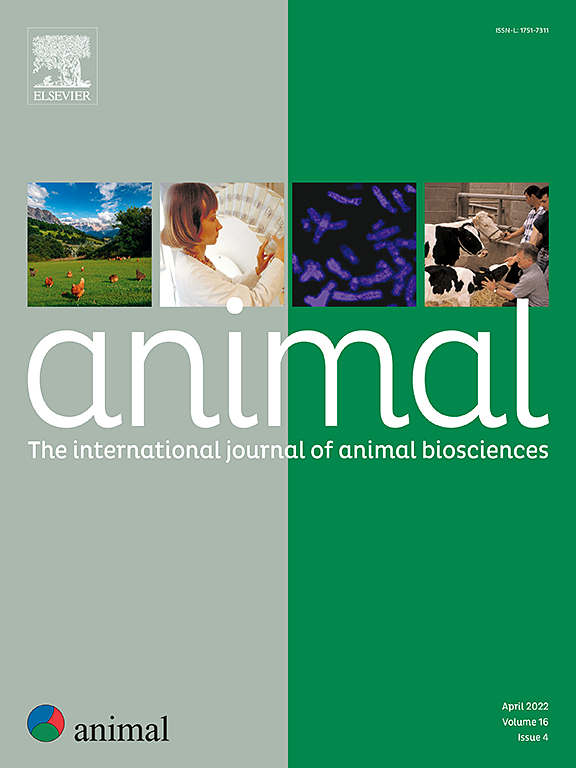对水牛种群产奶性状的选择特征和候选基因的基因组见解
IF 4
2区 农林科学
Q1 AGRICULTURE, DAIRY & ANIMAL SCIENCE
引用次数: 0
摘要
由选择驱动的牲畜遗传变异在基因组中留下了明显的特征。然而,中国水牛群体产奶性状的选择响应的综合格局仍然是难以捉摸的。本研究采用综合单倍型评分(his)和纯合性分析(ROH)对100头中国水牛全基因组序列数据进行分析,以破译选择特征。利用his和ROH鉴定出1 046个和1 045个重要的基因组区域,分别包含717个和263个候选基因。his和ROH的整合发现了258个候选区域和108个重叠基因,代表了真正的选择特征。此外,94个候选区域与672个先前报道的与关键经济性状相关的数量性状位点重叠。基因组区域的注释突出了与产奶性状相关的候选基因,包括SNORD42、COX18、ANKRD17、ALB、RASSF6、CXCL8、TMEM232、ARHGAP26和NR3C1。转录组关联分析支持ANKRD17和CEP41作为影响乳性状的潜在候选基因。本研究通过整合his和ROH方法,揭示了中国水牛种群的综合选择特征图谱。这些发现对改善全球水牛种群的产奶特性具有广泛意义,有助于建立更可持续的牲畜系统。确定的候选基因揭示了产奶性状的选择反应,为优化中国水牛的育种策略提供了重要的见解。本文章由计算机程序翻译,如有差异,请以英文原文为准。
Genomic insights into selection signatures and candidate genes for milk production traits in buffalo population
Genetic variability in livestock driven by selection leaves distinct signatures within the genome. However, the comprehensive landscape of the selection responses for milk production traits in the Chinese buffalo population remains elusive. This study employed an integrated haplotype score (iHS) and runs of homozygosity (ROH) analyses of whole-genome sequence data from 100 Chinese buffaloes to decipher selection signatures. Using iHS and ROH, we identified 1 046 and 1 045 significant genomic regions, containing 717 and 263 candidate genes, respectively. The integration of iHS and ROH revealed 258 candidate regions and 108 overlapping genes, representing true selection signatures. Additionally, 94 candidate regions overlapped with 672 previously reported quantitative trait loci associated with key economically important traits. Annotation of the genomic regions highlighted candidate genes linked to milk production traits, including SNORD42, COX18, ANKRD17, ALB, RASSF6, CXCL8, TMEM232, ARHGAP26, and NR3C1. Transcriptome-wide association analysis supported ANKRD17 and CEP41 as potential candidates for affecting milk traits. This study unveils a comprehensive selection signature profile for the Chinese buffalo population by integrating iHS and ROH methods. The findings have broad implications for improving milk production traits in buffalo populations globally, contributing to more sustainable livestock systems. The identified candidate genes shed light on the selection response for milk production traits, offering crucial insights into optimising the breeding strategies for Chinese buffaloes.
求助全文
通过发布文献求助,成功后即可免费获取论文全文。
去求助
来源期刊

Animal
农林科学-奶制品与动物科学
CiteScore
7.50
自引率
2.80%
发文量
246
审稿时长
3 months
期刊介绍:
Editorial board
animal attracts the best research in animal biology and animal systems from across the spectrum of the agricultural, biomedical, and environmental sciences. It is the central element in an exciting collaboration between the British Society of Animal Science (BSAS), Institut National de la Recherche Agronomique (INRA) and the European Federation of Animal Science (EAAP) and represents a merging of three scientific journals: Animal Science; Animal Research; Reproduction, Nutrition, Development. animal publishes original cutting-edge research, ''hot'' topics and horizon-scanning reviews on animal-related aspects of the life sciences at the molecular, cellular, organ, whole animal and production system levels. The main subject areas include: breeding and genetics; nutrition; physiology and functional biology of systems; behaviour, health and welfare; farming systems, environmental impact and climate change; product quality, human health and well-being. Animal models and papers dealing with the integration of research between these topics and their impact on the environment and people are particularly welcome.
 求助内容:
求助内容: 应助结果提醒方式:
应助结果提醒方式:


